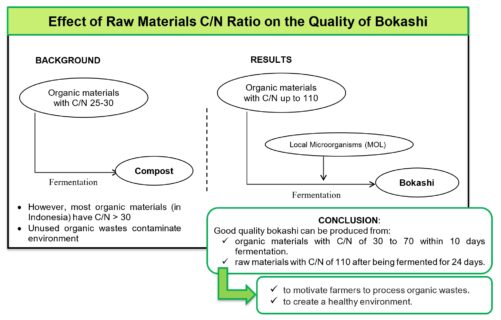Effect of raw materials C/N ratio on the quality of Bokashi
Authors
- Irfan * 1
- Dewi Yunita 1
- Muhammad Fadhil 1
- Fauzan 2
Abstract
Purpose: To assess the effect of C/N ratio in organic raw materials on the quality of bokashi and to obtain the proper C/N formulation of raw materials and fermentation time for bokashi production.
Method: The bokashi was made using a Completely Randomized Design (CRD) with two factors: the C/N ratio in raw materials (R: 30, 70, 110) and the fermentation time (L; 10, 17, 24 days). Then, the bokashi was evaluated for microbial and chemical properties. In the second stage, the bokashi was made using raw materials with C/N of 30 and 150 and fermentation time (0, 10 days) with 5 replications for analyzing the C/N. The pH and temperature were also observed every day during 10 days.
Results: The highest TCC (1.44×1011 CFU/g) was in the bokashi which produced from raw materials with C/N of 70. In general, C/N of bokashi was lower than that of initial raw materials; however, 10 days fermentation was not sufficient to decompose organic matter in raw materials with a C/N of 150 perfectly. Daily observations of the pH and temperature during 10 days fermentation showed a continuously increasing of pH, while temperature first increased and began to experience a constant decrease starting on the 8th day.
Conclusion: A good quality bokashi which match the soil C/N ratio range of 10-20 can be produced from organic raw materials with C/N of 30 to 70 within 10 days fermentation as well as from raw materials with C/N of 110 after being fermented for 24 days.
Research Highlights
- Organic waste in Indonesia generally presents a C/N ratio above 30.
- A good quality bokashi which match the soil C/N ratio range of 10-20 could be produced from organic raw materials with C/N of 30 to 70 within 10 days fermentation.
- Raw materials with a C/N of 110 can be decomposed after being fermented for 24 days.




